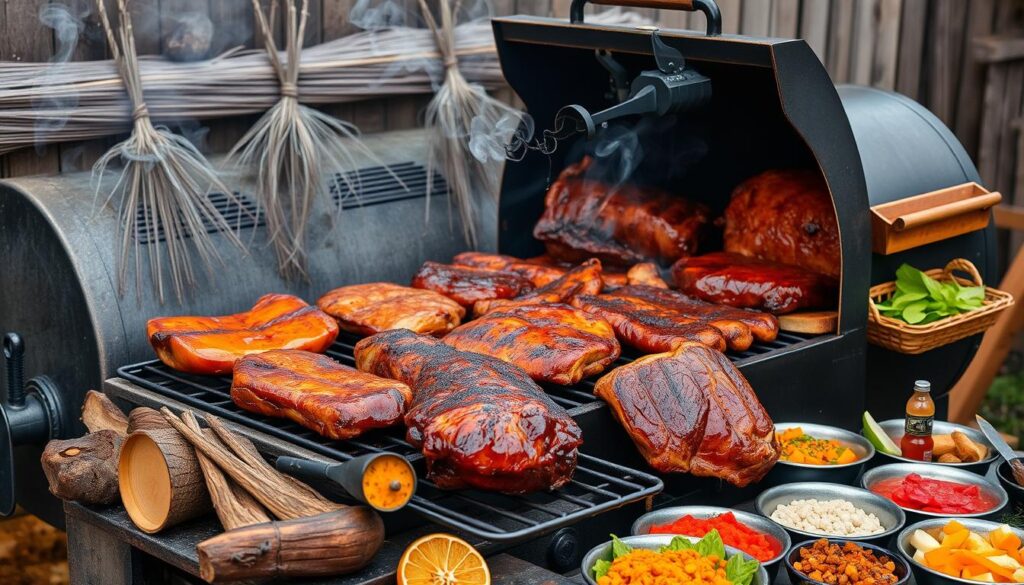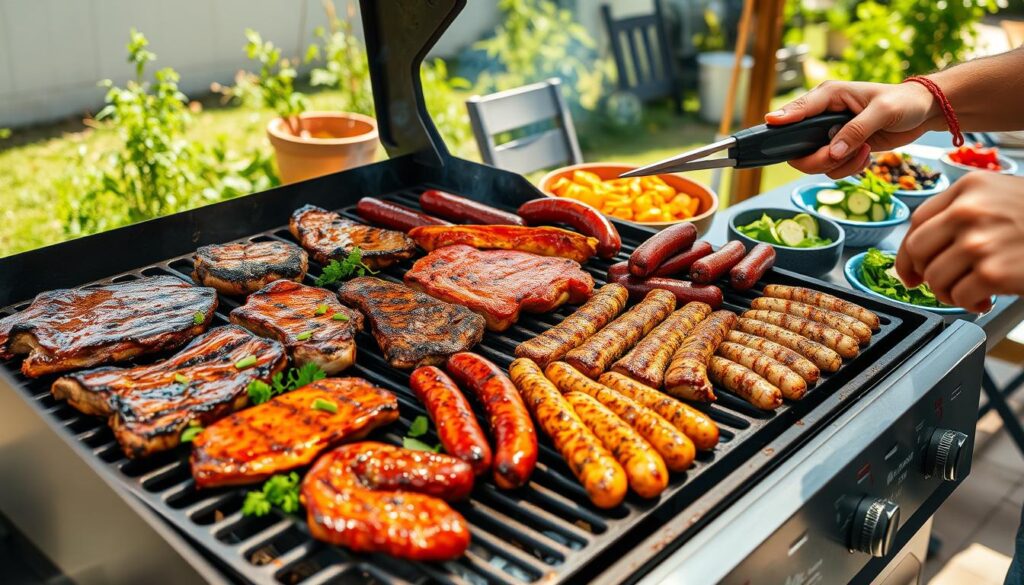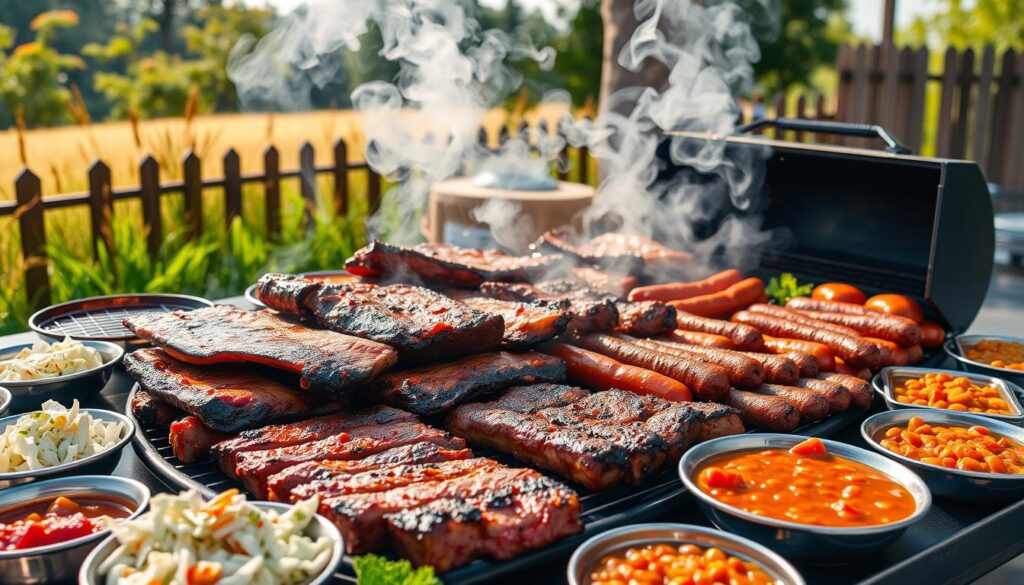Barbecue lovers are finding Meat Church recipes that turn grilling into an art. These recipes offer new flavors that make backyard cooking special. They go beyond simple cooking.
Meat Church recipes are for everyone, whether you grill a lot or just on weekends. They teach new ways to smoke and cook meats. You’ll learn to make brisket and pulled pork like a pro.
The secret to Meat Church’s success is in the smoking, choosing top ingredients, and controlling temperature. Each recipe is a detailed guide to making food that tastes like it’s from a restaurant.
Key Takeaways
- Meat Church recipes offer unique flavor combinations
- Smoking techniques are crucial for exceptional results
- Quality ingredients make a significant difference
- Precise temperature control ensures perfect meat preparation
- Both beginners and experts can learn from Meat Church techniques
Understanding the Meat Church Cooking Philosophy
Meat Church is a new way of looking at barbecue. It turns cooking into an art form. Pit masters use special smoking methods to make backyard grilling amazing.

Origins of Meat Church Cuisine
The Meat Church idea started with a love for traditional barbecue. Matt Pittman and his team saw smoking meats as more than cooking. It’s about making unforgettable moments with great flavors.
“Great barbecue isn’t just about food. It’s about bringing people together.” – Matt Pittman
Core Smoking Principles
Smoking well means knowing a few key things:
- Precise temperature control
- Understanding meat selection
- Managing smoke intensity
- Selecting appropriate wood types
Essential Equipment Guide
Your smoker is key to great results. Pit masters say get top-notch gear for steady heat and good smoke flow.
| Smoker Type | Best For | Temperature Range |
|---|---|---|
| Offset Smoker | Large cuts of meat | 225-250°F |
| Pellet Smoker | Easy temperature control | 180-500°F |
| Kamado Grill | Versatile cooking | 200-750°F |
Learning these basics will help you get better at Meat Church smoking. You’ll make barbecue that wows everyone.
Best Meat Church Recipes for Beginners
Starting with meat church recipes can seem scary, but it’s easy once you know how. You’ll learn to grill like a pro, impressing everyone with your skills. This section offers simple yet tasty recipes for newbies.

- Classic Smoked Chicken Quarters
- Beginner’s Pulled Pork
- Simple Beef Brisket Starter
“Great barbecue is about patience, passion, and practice” – Meat Church Pitmaster
When you start, focus on basic grilling skills. It’s all about controlling temperature, choosing the right meat, and seasoning it right.
| Recipe | Difficulty Level | Estimated Cooking Time |
|---|---|---|
| Smoked Chicken Quarters | Beginner | 2-3 hours |
| Pulled Pork | Intermediate | 8-10 hours |
| Beef Brisket | Advanced | 12-14 hours |
Begin with simple recipes that need little gear and ingredients. Get a good meat thermometer and learn to keep the smoker at the right temperature. With practice, you’ll get better at making perfect smoked meats.
Signature Meat Church Rubs and Seasonings
Take your barbecue to the next level with Meat Church’s legendary meat rubs. These seasonings turn simple grilling into a gourmet experience. They add bold flavors and expert taste to your backyard cooking.
Meat Church is known for its top-notch meat rubs that capture the true taste of barbecue. Their signature blends are made to boost the flavor of various proteins. This gives home cooks the taste of a pro.
Holy Cow Beef Rub
The Holy Cow Beef Rub is a must-have for steak and beef fans. It’s a powerful seasoning mix that includes:
- Coarse black pepper
- Kosher salt
- Garlic powder
- Specialized spice blend
Honey Hog BBQ Rub
The Honey Hog BBQ Rub is perfect for pork lovers. It offers a sweet and savory taste. The honey undertones caramelize beautifully when smoked.
Gospel All-Purpose Rub
The Gospel All-Purpose Rub is great for those who want a versatile seasoning. It works well on chicken, beef, pork, and even veggies.
“Great barbecue isn’t just about the meat – it’s about the seasoning.” – Meat Church Pitmaster
Learning to use these meat rubs will make your barbecue stand out. It will add professional-level flavor to every dish you make.
Mastering Smoked Brisket Techniques
Smoking brisket is a big challenge for BBQ lovers. It needs careful work, patience, and knowing how to smoke to make tough beef tender and full of flavor.
Finding the right brisket is key. Choose one with even marbling and enough fat. Prime or Wagyu beef is the best for smoking.
“Perfect brisket isn’t just cooking – it’s an art form that requires practice and passion.” – BBQ Pitmaster
Key Preparation Steps
- Trim excess fat to about 1/4 inch thickness
- Apply a generous layer of coarse kosher salt and black pepper
- Let the brisket rest at room temperature for 1 hour before smoking
Smoking Techniques
- Preheat smoker to 225-250°F
- Use post oak or hickory wood for classic flavor profile
- Maintain consistent temperature throughout cooking
Your smoking method affects the brisket’s texture. Cooking slowly is best – it takes 1-1.5 hours per pound. Watch for the critical stall point around 165°F, where moisture evaporation can slow cooking.
Pro tip: Wrap the brisket in butcher paper once it gets a dark bark. This keeps moisture in and speeds up cooking. You’ll get a tender, juicy brisket perfect for your BBQ.
Perfect Pulled Pork Preparation Guide
Pulled pork is the top of barbecue recipes, turning simple meat into a tasty masterpiece. To make delicious pulled pork, you need to know the best smoking methods.
Making great pulled pork takes skill, patience, and love. Let’s explore the key techniques to master this favorite barbecue dish.
Meat Selection Tips
Choosing the right cut is key for perfect pulled pork. Look for:
- Pork shoulder (Boston butt)
- Meat with lots of fat for flavor
- Choose one that’s about 8-10 pounds for the best results
Smoking Temperature Control
Keeping the temperature steady is vital in smoking. Aim for 225-250°F. Use a meat thermometer to check the meat’s internal temperature and cook it evenly.
“Low and slow is the golden rule of pulled pork perfection.” – BBQ Pitmaster
Resting and Pulling Techniques
After smoking, let your pork rest for 1-2 hours. This step makes the meat tender and juicy. When pulling, use two forks to shred it into tasty pieces.
With these tips and techniques, you’ll turn simple pork into a dish that will wow everyone.
Competition-Style Ribs Recipe
To excel in competition bbq, you need precision and passion. Meat Church recipes guide you to make ribs that wow judges and backyard fans alike.
Creating competition-style ribs requires focus and special techniques. It’s about knowing the small differences that make a big impact.
- Select premium pork spare ribs with consistent marbling
- Remove the membrane for optimal smoke penetration
- Apply Meat Church rubs generously
- Master the 3-2-1 smoking method
“Great barbecue is an art form that requires patience, practice, and passion” – BBQ Champion
Your smoking strategy is crucial. Keep the temperature steady at 225-250°F. Choose fruit woods like apple or cherry for a sweet smoke flavor.
| Smoking Stage | Duration | Temperature |
|---|---|---|
| Initial Smoking | 3 hours | 225°F |
| Wrapped Cooking | 2 hours | 235°F |
| Finishing | 1 hour | 245°F |
How you present your ribs is key in competition bbq. They should look glossy, taste tender, and have a balanced flavor. This shows off your Meat Church recipe skills.
Advanced Smoking Methods for Poultry
Take your barbecue to the next level with expert smoking methods for poultry. Meat Church techniques turn chicken and turkey into unforgettable dishes. They will wow your guests and delight your taste buds.
Smoking poultry needs precision and knowledge. The right grilling techniques can turn a dry, tough bird into a juicy, flavorful masterpiece.
Whole Chicken Preparation
Preparing a whole chicken for smoking involves several crucial steps:
- Pat the chicken dry with paper towels
- Apply a generous coating of Meat Church rub
- Let the chicken sit at room temperature for 30 minutes
- Truss the chicken to ensure even cooking
Turkey Smoking Secrets
Turkey needs special care when smoking. Temperature control is key to achieving a perfectly smoked bird. Start with a high-quality turkey and brine it overnight for maximum moisture and flavor.
Temperature Management Tips
Successful smoking methods depend on precise temperature control:
- Maintain a consistent smoker temperature between 225-250°F
- Use a reliable meat thermometer
- Remove poultry when internal temperature reaches 165°F
- Let the meat rest for 15-20 minutes before carving
“Patience and precision transform good barbecue into great barbecue.” – Meat Church BBQ Experts
Master these smoking methods and grilling techniques to create restaurant-quality poultry. It will be the star of any meal.
Essential Wood Selection Guide for Smoking
Choosing the right wood chips can make your barbecue amazing. The art of picking wood is key to creating rich flavors. These flavors can turn your smoked meats into gourmet dishes.
Each wood type adds its own special touch to your dishes. Knowing these differences can help you make dishes that wow everyone.
- Fruit Woods: Apple and cherry give sweet, mild flavors that are great for poultry and pork
- Strong Woods: Mesquite and hickory have intense smoky tastes perfect for beef
- Mild Woods: Pecan and maple offer subtle, balanced smoke flavors
“The right wood is like a secret ingredient that can make or break your barbecue.” – BBQ Pitmaster
Think about the meat’s density and the flavor you want when picking wood chips. Lighter meats go well with fruitwoods. Heavier meats can handle stronger woods.
| Wood Type | Meat Pairing | Flavor Profile |
|---|---|---|
| Apple | Chicken, Pork | Sweet, Mild |
| Hickory | Beef, Ribs | Strong, Bacon-like |
| Oak | Universal | Medium, Balanced |
Try different smoking methods and wood mixes to find your unique flavor. Remember, getting good at wood selection takes time and effort.
Pairing Sauces with Your Smoked Meats
Improving your barbecue recipes is more than just smoking. The right barbecue sauce can make a great smoked meat even better. Knowing which sauce to use and how to apply it is crucial for delicious dishes that wow your guests.
Choosing the perfect sauce is about understanding flavors and meat types. Each meat has its own favorite sauce, making sauce pairing an art.
Classic BBQ Sauce Recipes
Traditional barbecue sauces offer a variety of tastes:
- Kansas City-style: Sweet and thick tomato-based sauce
- Carolina Vinegar Sauce: Tangy and thin vinegar blend
- Texas-style: Spicy and bold with minimal sweetness
Regional Sauce Variations
Regional barbecue sauce recipes show off local tastes:
| Region | Sauce Characteristics |
|---|---|
| Memphis | Thin, tangy tomato sauce |
| Alabama | White mayonnaise-based sauce |
| St. Louis | Sticky, sweet tomato-molasses blend |
Sauce Application Timing
When to apply sauce is key for the best flavor and texture. Timing matters when putting barbecue sauces on smoked meats:
- Apply sauce during the last 15-20 minutes of cooking
- Brush thin layers to prevent burning
- Allow sauce to caramelize without scorching
“The right sauce can turn good barbecue into legendary barbecue.” – BBQ Pitmaster
Troubleshooting Common Smoking Issues
Mastering smoking methods means knowing how to solve common problems. Every pitmaster faces challenges, but with the right knowledge, you can overcome them. This way, you can make amazing smoked meats.
Temperature control is key to successful smoking. Your smoker setup greatly affects meat quality. So, it’s important to manage heat well.
- Check for air leaks in your smoker
- Use high-quality temperature probes
- Maintain stable fuel levels
- Protect your smoker from wind interference
“Great barbecue is 90% problem-solving and 10% cooking.” – BBQ Expert
Different smoking methods need different approaches. Knowing your smoker setup helps avoid common problems. These include uneven cooking or too much smoke.
| Problem | Potential Cause | Solution |
|---|---|---|
| Inconsistent Temperature | Poor Fuel Management | Use quality charcoal, monitor fuel levels |
| Excessive Smoke | Wet Wood Chips | Use dry, seasoned wood chips |
| Uneven Cooking | Hot Spots in Smoker | Rotate meat, use heat deflectors |
Remember, practice makes perfect. Every smoking session is a chance to get better. You’ll learn more about your equipment and techniques.
Conclusion
Diving into Meat Church recipes makes your cooking amazing. You’ve learned how to make delicious barbecue dishes. These dishes will impress everyone you share them with.
You now know how to pick the best rubs and control smoking temperatures. Your barbecue skills have improved a lot.
Meat Church techniques show that great barbecue is an art. You’ve learned about wood, meat, and flavors. This knowledge will help you make unique barbecue dishes.
Remember, practice and passion are important to become a barbecue master. Your skills will grow with each dish you make.
Your cooking journey is far from over. Every time you smoke, you can try new rubs and methods. You’ll get better at cooking brisket, pulled pork, and poultry.
Keep learning and let your creativity show in every dish. You’re ready to explore the world of barbecue cooking.
The Meat Church philosophy is about more than food. It’s about bringing people together and making memorable meals. Your barbecue journey is just starting.




